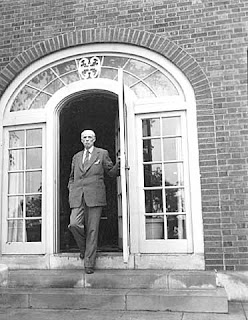Hastings, Minnesota, a town near the confluence of the Mississippi, Vermillion, and St. Croix Rivers, has many historic buildings, including the second oldest courthouse in the state, built 1869-71, and the Gothic Revival LeDuc House (1860). Hastings also has a downtown historic district containing dozens of buildings. It's no surprise that at least one of these would be reportedly haunted.
The LeDuc House
Second Street consists of a row of designated historic commercial buildings. The structure formerly occupying this land was that curious invention of Victorian boom towns, the portable frame structure. This ingenious building--which in this case housed a stable--was moved back and forth from lot to lot on log skids to avoid the spring quagmires inevitable at riverside locations.
In 1902 the Meyer (not their real name) family bought an 1886 building on Second Street to house their grocery and butcher shop. In the 1980's, Martin, of the second generation of Meyers, began researching the building because of a strange experience he had there one midnight. Previous to this experience Martin had spent thousands of hours in the building, but only during shopping hours. When his father and uncle ran the business, nobody ever worked there at night except the uncle. The pressures of running a market during the 'Twenties and 'Thirties were too great for a shopkeeper not to work outside business hours, and the uncle took up this task.
The front of the former grocery and butcher shop.The uncle used to say matter-of-factly that the building was haunted. These comments were shrugged off by the rest of the family. They considered the uncle rather eccentric, and his stories were written off as hallucinations. But the fact remained that the uncle was the only one bold enough to work in the store late at night.
Several decades after the uncle's nocturnal labors, his nephew Martin found himself in the position of needing to stay late at the store. It was the week before Christmas, and many special orders of sausage and cold cuts for holiday parties were waiting to be filled. So, one cold December night Martin decided to stay in the closed shop to finish making sausage. Except for the noises he made moving around the shop, all was still as only a winter night can be.
All went well until shortly before midnight. Martin was in the back of the shop running the sausage machine when he thought he heard a noise up front. As he walked into the front room, he heard a dull metallic clattering. He glanced around, trying to discern the source of the sound. He soon realized that it was coming from inside the chimney.
The hair on the back of his neck stood on end as he heard the unmistakable sounds of heavy chains being dragged against the bricks. The sound was loud and harsh; it swelled, it grew, it seemed to fill the entire building. For a few seconds Martin was paralyzed with fear. What in the world could be making this ghastly racket?
In a burst of speed, Martin grabbed the sausage meat and literally threw it into the cooler. The chains kept rattling, ever louder. Grabbing his coat as he ran to the back door, Martin slammed off the lights, and left the building. He hastily locked the door and sprinted to his car. When he reached the car, he looked back at the dark building. No movement was visible inside or out. An earthly silence filled the winter night.
Not until he arrived home and told his wife about his experience did Martin recall his now-deceased uncle's insistence that the building was haunted. Martin realized that his eccentric uncle was not hallucinating after all. The heavy ominous chain-rattling, reminiscent of the Ghost of Christmas Past's visit in the Dickens' tale, seemed real to Martin, real enough, in fact, for him not to try any midnight sausage runs again.
It's impossible to know who or what was doing this scary
chain-rattling--someone from before the town was built, or from the
stable, or from the 1886 building. The story of chains being dragged
inside a chimney was reported to me by two other people I collected
stories from, although these were in houses, not a commercial building.
Although it might seem a cliche today, the story of ghostly chains can be found in stories from ancient times. The Roman writer Pliny the Younger 'wrote to his friend Sura that "In the dead of the night a noise, resembling the clashing of iron, was frequently heard, which, if you listened more attentively, sounded like the rattling of fetters; at first it seemed at a distance, but approached nearer by degrees; immediately afterward a phantom appeared in the form of an old man." ' [Wikipedia, Jacob Marley].
* * *
A tip of the hat to the late Hazel Jacobsen-Theel, Hastings historian, for providing historical background and introducing me to "Martin", whose family owned the butcher shop.








No comments:
Post a Comment